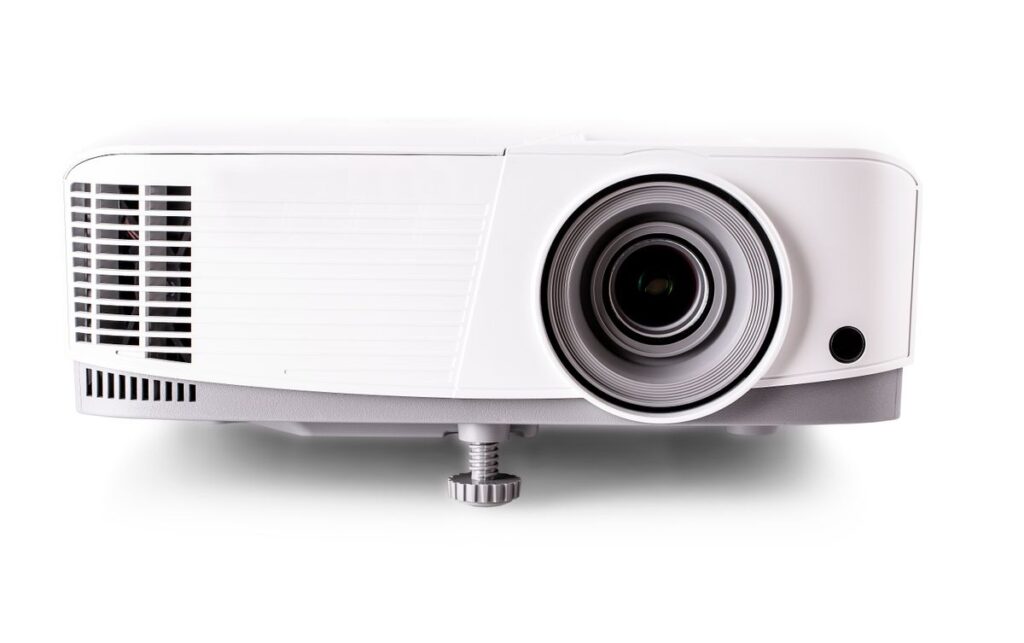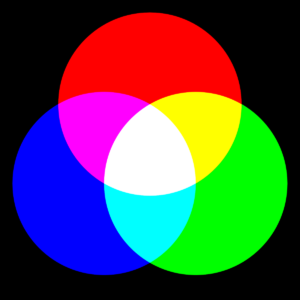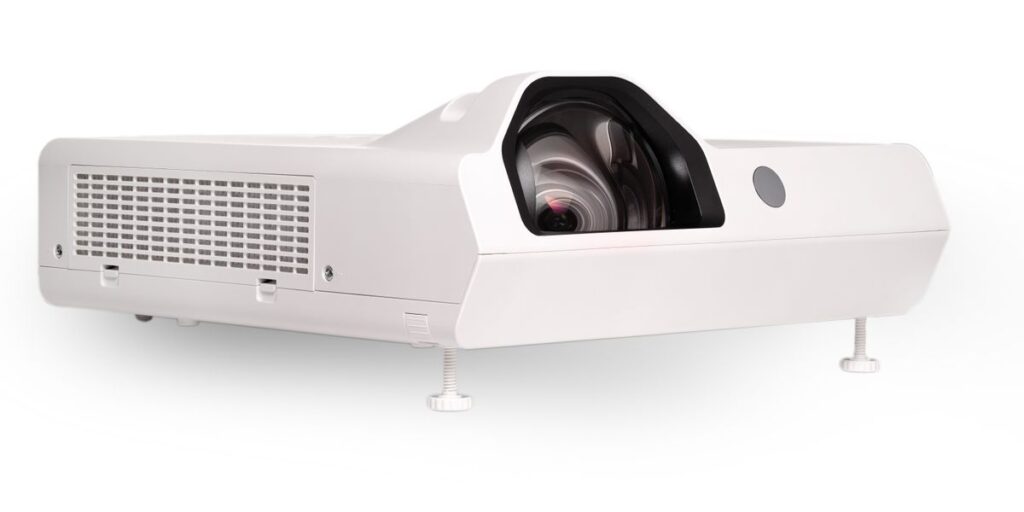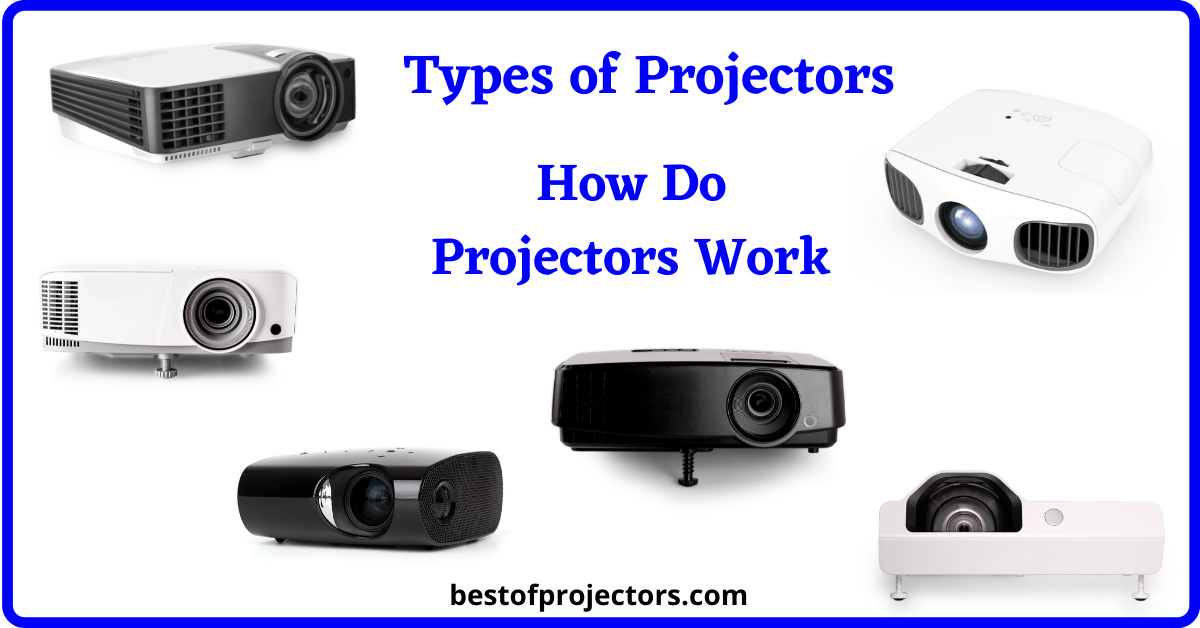Last Updated on June 30, 2024 by Admin
Since various types of projectors operate differently, we’ll cover both the different projector types and their workings simultaneously.
In this article, we’ll explain the Projector Types and take a look at the basic principles behind how does a projector work. So, prepare to be enlightened as we unveil the secrets behind the magic of projectors.
Also, check out What is a Projector.
Page Contents
How Does a Projector Work?
Ever wondered how projectors bring images to life on the big screen? Let’s break it down. Projectors work like magic lanterns, but instead of candles, they use light bulbs or lasers to cast light through an image. This light then travels through lenses and mirrors, getting magnified and focused onto a surface, like a wall or a screen.
That’s the most basic way of explaining How do projectors work. But, different types of Projectors have different mechanisms, projection technology, and light sources. Let’s dive deep into how all Types of Projectors work.

Exploring Different Types of Projectors & How They Work:
Projectors can be classified in many ways. Like Projection Technology, Light Source, Use, Projection Quality, Throw, and more. But, mostly, they are classified by their Projection Technology.
We will also talk about Pico Projectors, Laser Projectors, Rear-Throw Projectors, and more.
Types of Projectors based on Projection Technology:
CRT Projectors:
When projectors were introduced during the 1950s’, they were CRT (Cathode Ray Tube) Projectors. In fact, CRT projectors were once the reigning kings of home entertainment, presenting exceptional image quality and color accuracy.
How CRT Projectors Work:
The CRT Projectors used three cathode rays that are Blue, Green, and Red colors. When all three lights hit the screen, they combine and create a colorful image.
Advantages of CRT Projectors:
- Excellent black levels and contrast ratio.
- No rainbow effect.
- Superb color accuracy and saturation.
- No pixelation or motion blur during fast-moving scenes.
- Enjoy high image quality even when watching at wide angles.
- Suitable for low-light environments.
- Long lifespan and less maintenance.
- Immersive viewing experience with realistic image rendering.
Drawbacks:
- Bulky and heavy design
- High power consumption
- Require adequate ventilation due to heat generation
- Low brightness output compared to modern technologies.
- Exposure to image distortion.
- Expensive compared to other Projector Technologies.
- Difficult to find as CRT Projectors have been discontinued.
- Complicated setup.
- Requires regular maintenance.
- Not suitable for high-definition content.
- Risk of screen burn-in with prolonged static image display.
- Limited connectivity options.
The quality of the CRT Projectors hasn’t improved over time. Therefore, manufacturers are not producing these anymore, due to low demand. They started building Projectors with the latest technologies like DLP and LCD.
DLP Projectors:
DLP stands for Digital Light Processing. These Projectors use millions of Microscopic mirrors to produce an image. DLP Projectors took over CRT Projectors, and are still preferred by many users, especially Gamers.
How Does Projector Work-DLP:
The light source is located at the end of the setup, which is called a Lamp. It emits light into a spinning color wheel and passes through a mirror setup (Also called DMD – Digital Micromirror Device).
There are millions of mirrors, and Each mirror is associated with a light point. When the light falls on the mirrors, they correspond to the light source with a tilting movement based on the color of the light. The mirrors are microscopic and their movement is very subtle. So, we cannot notice it with plain eyes.
Finally, the DMD converts the RGB lights into an image and reflects towards the lens. The Lens, which is located at the front end of the Projector displays the image in a bigger size.
The concept of DLP Projectors was inspired by the Chinese Magic Mirrors.
Advantages of DLP Projectors:
- Can also project 3D content
- Faster Response Time
- Smooth motion performance
- Emits Smart Images with Superior image quality & vibrant colors
- Doesn’t require filters
- Compact and portable design requires Less Space
- Long-lasting reliability
- Lower power consumption
- Flexible installation options
Drawbacks of DLP Projectors:
- The color wheel could create a rainbow effect on the projected images, which is called Color Ghosting.
- The moving parts (color wheel) create noise.
- Limited black levels and contrast ratio
- DLP chips may degrade over time
- Light output may decrease over the projector’s lifespan
It is the most commonly used type of projector used in business today. Also, it is more expensive than LCD projectors.
LCD Projectors:
The LCD Projectors use Liquid Crystal Displays. It came with only 1 chip before. But now, most of the latest Projectors come with 3 chips. Hence, they are also called 3LCD Projectors. The 3-chip LCD Projectors offer better color saturation and lower noise levels.
How LCD Projectors Work:
The LCD Projectors use LCD Panels instead of the color spinning wheel. All Types of Projectors have a Light Source at one end, and a Lens on another. The LCD Projectors (Also described as 3LCD) have three LCD panels aligned straight to the light source (Lamp).
The light from the first LCD panel reflects red light and passes Blue light to the other two panels. Similarly, the second LCD panel reflects Green light and transmits blue light to the third panel. The third panel reflects the Blue light. All three lights are combined into a prism-like structure and emit the actual image. The lens at another end of the Projector magnifies the image and displays it on the surface.
Advantages of LCD Projectors:
- Provides a better experience while watching movies.
- The 3-chip Projectors offer better color saturation.
- No moving parts result in Quiet operation with minimal fan noise
- Bright and dynamic colors with high accuracy.
- Minimal maintenance & Low Power Consumption.
- No rainbow effects
- Outstanding image clarity and sharpness
Drawbacks of LCD Projectors:
- Filter needs to be changed frequently for LCD Projectors.
- Lower contrast ratio compared to DLP and LCoS
- Limited motion handling capabilities
- It has a Larger and bulkier design compared to DLP Projectors.
- Reduced black levels and shadow detail
- Limited lifespan of LCD panels
LCOS Projectors:
LCOS (Liquid Crystal on Silicon) projectors are like a fusion between DLP and LCD technologies.
LCOS projectors offer smoother images without the rainbow effect seen in some DLP projectors. It also provides deeper black levels compared to LCD models. LCOS projectors can handle high-resolution content and deliver detailed images, hence they are favored for home theater setups and professional presentations.
Although they are generally more expensive than other projector types, LCOS projectors offer a premium viewing experience for those who desire uncompromising image projection.
How LCOS Projectors Work:
LCOS (Liquid Crystal on Silicon) projectors work like a fancy sandwich.
In LCOS projectors, liquid crystal panels are mounted on a reflective silicon chip, allowing for high-resolution images with exceptional color accuracy and contrast.
There is a tiny chip made of silicon (like in your computer) inside the Projector. On this chip, there are millions of super tiny mirrors. These mirrors can tilt and move, kind of like tiny robots. There are liquid crystals behind these mirrors, just like what’s in your TV.
When light from the lamp falls on these mirrors, they tilt and reflect the light.
The liquid crystals then help to control the amount of light each mirror reflects. All this happens super quickly, creating the colors and images you see on the screen.
LCOS projectors are loved for their sharp, detailed pictures and vibrant colors. Hence, these are a perfect choice for watching movies or giving presentations with lots of graphics.
Advantages of LCOS Projectors:
- Produces High Image Quality with vibrant colors and excellent contrast.
- LCOS technology minimizes pixelation resulting in Smooth Image Rendering.
- LCOS projectors support high-resolution content such as HD and 4K video.
- Unlike some DLP projectors, LCOS projectors do not produce the rainbow effect.
- These Projectors are capable of producing Deep Black Levels.
- LCOS projectors offer wide viewing angles, making them suitable for larger audiences.
Drawbacks of LCOS Projectors:
- LCOS projectors are more expensive than other projector technologies.
- These Types of Projectors can be larger and heavier than some other projector types.
- Even with smooth motion performance, there is a possibility of Motion Blur.
- Can Generate significant heat during operation.
LCOS is still new to the market. Therefore, it would be hard to find the LOCS Projector of your choice with the features you desire, at least for the next couple of years.
Different Types of Projectors based on Light Source:
Basically, we can also classify Projectors by the Light Source they use. There are three types of Projectors based on the light source.
You might also think How does a Projector Work if the light source is changed? It works exactly the same. We simply replace the light source.

Lamp (Bulb) Projectors:
Both DLP Projectors and LCD Projectors use a Lamp as the Light Source. The Lamp worked great as a Light Source. However, the life of a Projector Lamp/Bulb was approximately 2000-5000 hours. So, if you are using Projectors for longer use, you might want to change the Projector Lamp every 6 months or so. Moreover, the Lamps are quite expensive. Therefore, other technologies were introduced.
LED Projectors:
As I mentioned before, LED projectors are not much different than DLP and LCD Projectors. The Projector Lamps had a short life, and sometimes they would even heat up and burn (in rare cases). So, the manufacturers decided to replace the Lamp with LED. The LED Projectors have LED panels placed as Light Source, instead of Lamps.
In DLP Projectors, the LED would emit white light. Whereas, in LCD Projectors, the RGB panels are replaced by Red, Blue, and Green LEDs. LED Light Source emits impressive colors, better contrast, and has a longer life span. Moreover, it would consume less power and would not heat up the Projector as the Lamps did.
However, they have limited brightness. Therefore, many users still prefer Lamp Light sources over LED.

Laser Projectors:
Looking at the Drawbacks of Lamp Projectors and LED Projectors, engineers have decided to create a better Projector type. Hence, they started using Laser as the light source instead of Lamp or LED. The Laser Projector not only emits better picture quality but also has over 20000 hours of lifetime.
Besides that, the startup time was improved, and the images were much brighter. On the other hand, Laser Projectors are very expensive. Also, the black levels are better on Lamp Projectors.
Besides Technology and Light Sources, Projectors can also be classified by Output resolution like 4K Projectors, HD Projectors, etc. and there are also different types of Projectors like Mini Projectors, Portable Projectors, LCoS Projectors, and more.

Types of Projectors based on Throw:
Many may question that How Does a Projector Work? Well, the parts of the Projector as same. They just change the distance between these parts to make the difference.
Based on Projector Throw, Projectors can be classified into 3 Types.
- Short-throw Projectors: Designed to project large images from a short distance, ideal for small rooms or tight spaces.
- Ultra-short-throw Projectors: Can project images from very close to the screen or wall, often used for interactive displays or digital whiteboards.
- Long Throw Projector: Used when the Projector needs to be placed far from the screen or wall.
We did a detailed comparison between Ultra Short Throw Vs Short Throw Vs Long Throw Projector. You can see their Pros and Cons as well.
Types of Projectors based on Projection Quality:
We can differentiate projectors based on their Projection Quality as well. Some Projectors can throw 4K ultra-high-definition resolution, while some are capable of Projecting 3D content.
Remember, if you get a 720p resolution projector and play 4K video, it may support the video format, but it won’t project in 4k image quality.
Types of Projectors based on Use:
Projectors can be used in several different sectors as we have explained in our previous article “Uses of Projectors“.
- Home Theater Projectors: These are Designed specifically for high-quality movie and entertainment experiences at home.
- Business/Commercial Projectors: Tailored for presentations, meetings, and conferences in professional settings.
- Portable Projectors: Compact and lightweight projectors suitable for on-the-go use and traveling.
- Outdoor Projectors: These projectors have high lumens and other features that let you Project content outdoors even in sunlight.
You can check out the Best Outdoor Projectors here.
Other Types of Projectors:
- Pico Projectors: Extremely compact projectors that can fit in the palm of your hand, suitable for casual use and small gatherings.
- Interactive Projectors: Enable users to interact directly with the projected images, often used in educational or collaborative environments.
Projectors can also be classified by their direction of Projection. Some Projectors are placed in front of the screen, hence they throw Front Projection. However, sometimes, you need to place Projectors behind the Screen, which is called Rear Projection System.
Which is more valuable? Check out this article to find out. Rear Projection vs. Front Projection

Conclusion:
In conclusion, projectors come in different types, each with its own special features and uses. Understanding the Types of Projectors, and how does a projector work will be beneficial in choosing the Best Projector for your needs. To find the best suitable Projector of your choice you can check out our Projector Buying Guide.
There are different types of Projectors if we classify them into different categories. But, the most important classification is based on Technology. As CRT Projectors are discontinued, there are only three types of Projectors that are DLP, LCD, and LCOS.
LED, Laser, and Lamp are different types of Light sources in a Projector. We will be updating this article from time to time to provide an update about the Latest Technology changes in Projectors.

